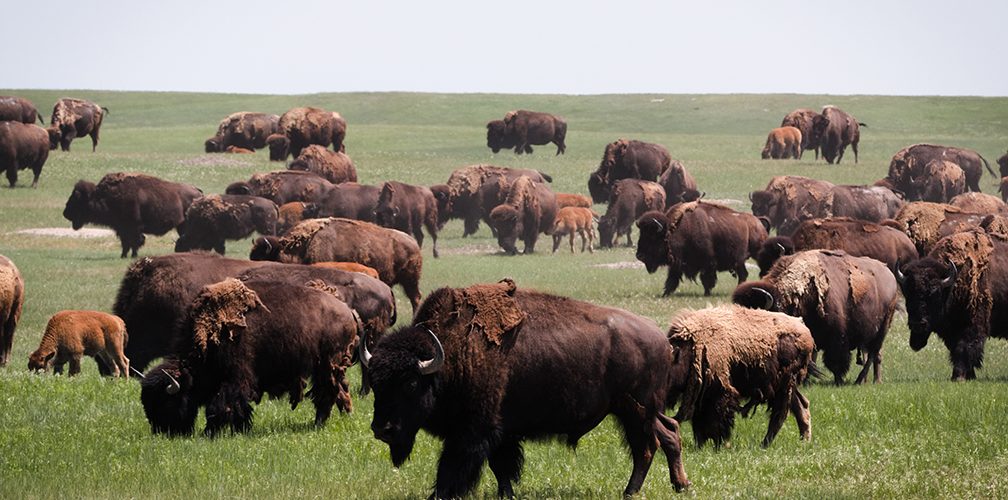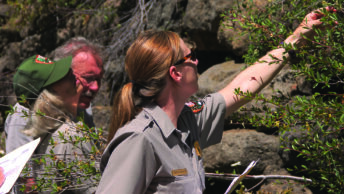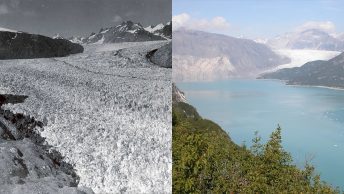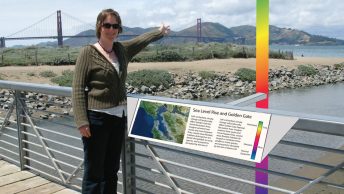A.N. Runyon, A.R. Carlson, J. Gross, D.J. Lawrence, G.W. Schuurman
Introduction
Managers and scientists widely acknowledge climate change as one of the greatest threats to protected areas in the US and worldwide (Gross et al. 2016). The US National Park Service (NPS) began addressing climate change as early as the 1990s, and in 2010 NPS Director Jonathan Jarvis stated that “climate change is fundamentally the greatest threat to the integrity of our national parks that we have ever experienced” (NPS 2010). Today, parks throughout the NPS system experience impacts of human-caused climate change (e.g., Monahan and Fisichelli 2014; Gonzalez 2018) that threaten iconic park resources. Climate-related impacts include: melting glaciers (e.g., Glacier National Park, Kenai Fjords National Park; Burgess et al. 2013); thermokarst formation effects on archaeological sites (Gates of the Arctic National Park and Preserve; Gaglioti et al. 2016); loss of Joshua trees (e.g., Joshua Tree National Park; Sweet et al. 2019); and sea-level rise threatening historic lighthouses (e.g., Cape Hatteras National Seashore; Schupp et al. 2015), historic artifacts (Anderson et al. 2017), and seaside forts (e.g., Dry Tortugas National Park; Schupp et al. 2015). Droughts, heat waves, floods, smoke, and fires associated with increasing temperatures and altered hydrological regimes now routinely affect park resources and visitors, and these impacts are in no way unique to US parks—protected area managers worldwide are challenged to rapidly adapt their management to address ongoing and projected climate change.
NPS established its Climate Change Response Program (CCRP) in 2009 to support climate-informed management for all resources,1 assets, and values across the US national park system. However, this system of over 400 individual park units is immense and diverse, and therefore requires an efficient, repeatable, and customizable process for developing adaptation strategies. Through numerous collaborations with park managers, planners, climate scientists, scenario experts, and others, CCRP has refined methods for developing and applying climate futures and scenarios to support national park management (NPS 2013; Star et al. 2016). Here, we describe a range of scenario-based approaches that range from simple to complex, and can be adopted and widely used to support climate change adaptation for parks and other protected areas.
Using climate change scenarios to support adaptation in US national parks
Scenarios are an important tool to support management strategies and decisions in situations of consequential and irreducible uncertainty, and their application is called scenario planning. Scenario planning has a rich history of use by industry and the military (van der Heijden 1997), and more recently in conservation and climate change adaptation (Peterson et al. 2003; Rowland et al. 2014). It is a flexible tool that is useful for understanding potential climate change implications and uncertainties by using a structured process to examine a range of possible futures that managers may face (IPBES 2016). It also provides a foundation for adaptation, including conducting vulnerability assessments and updating current management goals and strategies to ensure feasibility and effectiveness. The purpose of scenario planning is to consider not just what is thought to be most likely, but instead to challenge and move beyond preconceived notions about the future and consider the full range of plausible conditions so that management decisions are better informed and actions are more likely to succeed (Figure 1; NPS 2013). Scenario planning has wide potential application in resource management planning and decisionmaking, including not just addressing climate uncertainties but also others of consequence.
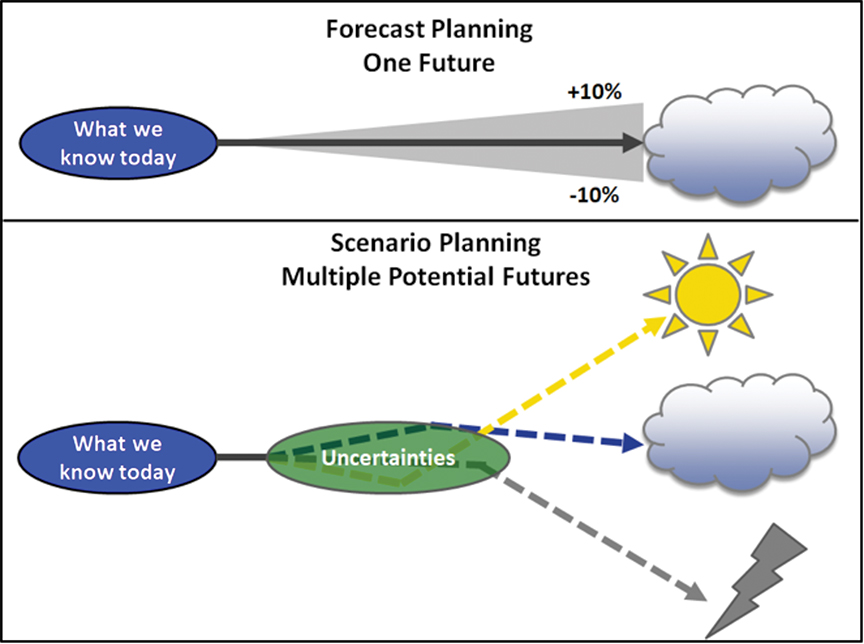
When engaging with parks to support resource management decisions, CCRP works iteratively with park staff and resource experts to (1) create climate futures from climate model projections; (2) develop climate–resource scenarios based on climate futures; and (3) use these scenarios to inform decisionmaking (Figure 2). The number of park resources addressed in a climate change scenario effort can range from a single, highly consequential resource to a broad set of resources (see case studies below). Scenarios developed from these engagements also span a range of depth—from general implications to full vulnerability assessments.

Development of climate futures and scenarios
It’s tough to make predictions, especially about the future. —Yogi Berra
Successful resource management requires anticipating the future as much as possible, but climate change is inherently complex and frequently impossible to reduce to a single useful forecast. The best available sources of information to support climate change adaptation are projections made by general circulation models (GCMs), which use scientific understanding of Earth’s climate system to predict future climatic conditions under multiple plausible levels of greenhouse gas emissions (emissions pathways are defined by the Intergovernmental Panel on Climate Change as representative concentration pathways, or RCPs;2 IPCC 2014). Because our understanding of Earth’s climate is incomplete, multiple GCMs produced by various institutions worldwide provide differing—yet plausible—projections of future climate.
To work with model- and emissions-related uncertainties, we developed a standardized, quantitative method for expressing the range of individual model projections for a particular park in terms of a limited set of discrete climate futures. The method is designed for rapid implementation and ease of interpretation, with opportunities to tailor the approach to a park’s planning needs. We use a modified quadrant approach (Rowland et al. 2014) in which we plot each projection, in terms of degree of change relative to a historical baseline, on one or more two-dimensional plots with axes representing key climate variables (Figure 3). Changes in key climate variables are averaged over a future period relevant for park management decisions (i.e., typically 10–40 years out). Then, quantile limits are used to group GCM/RCP projections into ranges for these variables (black box, center of Figure 3). Projections representing the more extreme ends may be grouped into nominal categories representing projection divergence, such as “Warm” vs. “Hot” for temperature, and “Dry” vs. “Wet” for precipitation. This method of using the GCMs to produce the climate futures was derived from an approach pioneered by the Volpe National Transportation Systems Center (Lee et al. 2015).
The purpose of defining climate futures is to consider plausible changes in climate variables so that potential effects on resources may be anticipated, and adaptation strategies developed. Certain components of climate future development require expert judgment. For example, we may choose to focus on a subset of divergent futures that are most relevant for a particular park, such as by comparing the “Warm Wet” with the “Hot Dry” climate future in a park where water scarcity is, or may become, a key issue. We may also define climate futures using climate variables tailored to specific resources, particularly when developing more targeted or detailed scenarios. Furthermore, for some applications it may be more appropriate to consider individual projections representing the “most extreme” futures as opposed to considering (less divergent) multi-projection averages. Selecting individual projections requires expert assessment of model suitability for a particular planning purpose, geographic location, and climate variable.
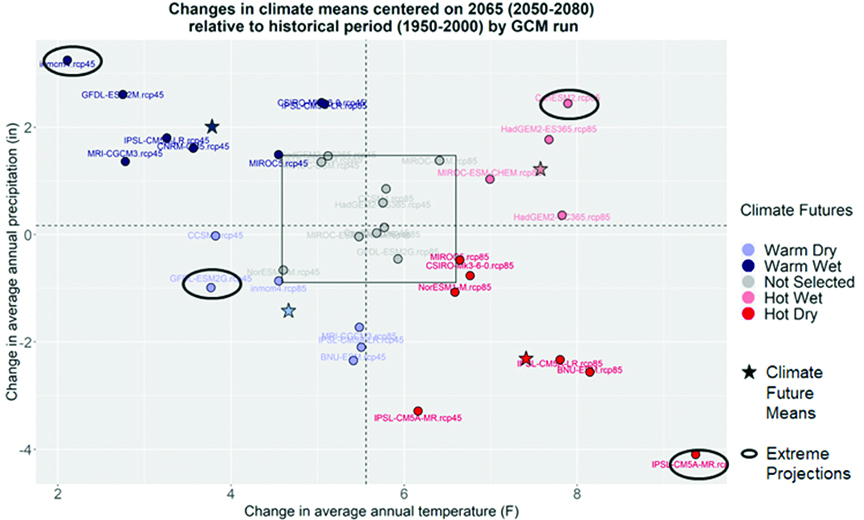
Figure 3. Climate futures plot demonstrating divergence among projections of average annual precipitation and temperature, relative to a historical baseline. Dashed lines indicate the mean value of all projections for each axis and the box indicates a central tendency, in that it includes projections inside of the 25th and 75th percentiles for both axes. For each climate future, the average of all projections in those quadrants is represented by a star, and the most extreme projection in the quadrant (i.e., that with the greatest change in precipitation or temperature relative to the average of all projections) is indicated by a black circle.
Although the CCRP approach is standardized, it is not static—climate change science continues to advance and parks continue to present new management concerns and climate vulnerabilities. We therefore iteratively improve our methods for calculating climate variables (e.g., in response to improved downscaling and bias correction methodologies) and expand our set of derived climate variables (e.g., number of freeze–thaw cycles/year, which is relevant to historical structures; Schuurman et al., in press). Updating methods for calculating variables enhances our ability to address new vulnerabilities and enrich scenario relevance to park concerns.
In the case studies below we describe a flexible approach to climate future and scenario development that can be tailored to address park managers’ needs.
Scenario-based vulnerability assessment for Big Bend National Park
On one end of the spectrum is a scenario planning activity focused on a specific location, resource issue, and management question. Responding to a technical assistance request from staff at Big Bend National Park (BIBE), CCRP evaluated changing climate conditions to provide supporting information for water development decisions in the Chisos Basin. The basin is one of the most visited areas of BIBE, given that its high elevation offers milder temperatures and the developed area there contains a visitor center, general store, lodge, and the only restaurant in the park. Over the past 10 years, Oak Spring, the current (and sole) water source for the basin, experienced intermittent drought-related reductions in flow, which in turn led to a need for water conservation measures by concession operators and visitors. Infrastructure supporting the acquisition and delivery of water from Oak Spring to the basin is also aging and BIBE plans to replace/repair this 1950s-era drinking water system in fiscal year 2022 at an estimated cost of $8–10 million. Before proceeding with the redevelopment of Oak Spring, park staff contacted CCRP to evaluate the implications of a changing climate on it. Park staff wished to analyze how changing climate conditions could affect the reliability of this water source, which depends in large part on annual precipitation for recharge.
Using a statistical model relating local precipitation to Oak Spring discharge, we developed quantitative projections of Oak Spring flow intended to bracket the plausible range of conditions from “best-case” to “worst-case” climate projections. Flows below a threshold of 20 gallons per minute (gpm) challenge BIBE operations in the Chisos developed area, and may invoke a drought conservation plan. We analyzed climate projections against this threshold, focused on two extreme projections of plausible climate futures (i.e., a Warm Wet and Hot Dry future). These two projections met our overall scenario selection criteria (i.e., plausible, relevant, divergent), essentially providing a “no surprises” examination of potential conditions that may affect water availability at Oak Spring. Using the model relating precipitation to Oak Spring flow, we examined how precipitation projections under each climate future may change the spring’s flows. We centered the analysis on the 2060s (2050–2080) because park staff identified this period as most relevant to their decisions.
Under the (best-case) Warm Wet scenario, climate projections for the 2060s indicate that both annual precipitation and the extremes of precipitation increase (i.e., the highs will be higher, and the lows generally lower). Although the total amount of precipitation increases under the Warm Wet scenario, the average number of months per decade where Oak Spring falls below 20 gpm remains similar to the historical (1950–2000) average. This is due to the increasing precipitation variability projected under this scenario, which oscillates between years with high annual precipitation relative to the historical period followed by relatively low-precipitation years.
Under the (worst-case) Hot Dry scenario, 2060s projections indicate the number of months per decade in which Oak Spring flows fall below 20 gpm is more than double the historical average (a statistically significant increase from 14 months per decade to 33 months per decade). For reference, Oak Spring fell below the 20-gpm threshold during 35 months over the observed period from 2007–2017, in large part reflecting the hydrological drought of 2012. Under this scenario, the reliability of Oak Spring as a water source may be especially compromised.
This evaluation explored plausible scenarios of climate change to assess implications for the future projected discharge of a critical water supply in BIBE. Accurately forecasting the most probable climate future is impossible, thus the tool of scenario development and analysis assists decisionmaking: by evaluating different scenarios of plausible and divergent conditions suggested in climate change scenarios, managers can stress-test water development decisions related to Oak Spring, while considering how climatic changes influence long-term reliability of this water source.
Considering the scenario information in concert with other factors, park management decided to undertake measures to proactively enhance reliability of Oak Spring as a water source into the future (B. Krumenaker, BIBE superintendent, personal communication). These measures include work to (1) use water more efficiently; (2) improve infrastructure to decrease water loss due to leaks; and (3) increase the storage capacity of water tanks that temporarily store Oak Spring water, so that it is available in drought periods. A full report is being prepared (Lawrence and Runyon, in press).
Informing resource stewardship planning with climate futures
Our “scenario-light” approach is the most basic application of climate change scenarios to support adaptation in resource management, where implications for a broad set of resources are considered in relation to general climate futures, as described above. We use this approach to help NPS meet an ambitious goal to produce a new or updated Resource Stewardship Strategy (RSS) for managing natural and cultural resources for over 200 national parks. An RSS is intended to help park managers achieve and maintain desired natural and cultural resource conditions over time. For each RSS, we present information on historical (observed) and projected climate trends, park-specific impacts, and climate change adaptation. For such a large number of plans and workshops, a streamlined, scenario-light approach is practical and effective in introducing the concept of divergent climate futures. This is a good starting point for those new to climate change scenario planning who seek to develop and use climate futures to inform and support decisionmaking. Presenting climate futures allows us to introduce the concept of scenarios without the full effort required to build them into climate–resource scenarios (Figure 2).
Climate futures are central to the support we provide to park plans in addressing climate change. For most RSSs, we analyze the two most relevant climate futures in detail. For example, where fire or water scarcity is important, we may select Warm Wet (best-case) and Hot Dry (worst-case) futures to examine in depth.
At a minimum, these climate futures include projected changes in annual and seasonal temperature and precipitation, as well as extremes of these variables (e.g., days per year >100F, days per year >32F). Because it can be difficult to infer resource impacts from temperature and precipitation changes alone, especially where both increase simultaneously, we also model water balance. Changes in water availability, which reflect changes in both precipitation and temperature, are almost always important to park resources. We therefore integrate temperature and precipitation using a simple water balance model that estimates changes in soil moisture, evapotranspiration, and ecological water deficit (Lutz et al. 2010), where water deficit is the difference between the amount of water available to plants and the amount of water that plants could use if it were available. Depending on a park’s circumstances (wet or dry climate, etc.), changes in water balance can have implications for surface and/or groundwater flows, fire hazards, plant distribution and growth, forage availability, and other processes important to park management (Bonan 2008). Furthermore, water deficit may also serve as a measure of drought.
The scenario-light approach is useful for reducing the daunting volume of climate change information into two or three credible, easily understood stories about future climates. Using this approach, we can compare historical observations to projections for best- and worst-case futures. As an example, for the Bandelier National Monument RSS, we used our simple water balance model to calculate changes in soil moisture and drought. Model projections showed that plant-available moisture would remain about the same only under the best-case climate future. In contrast, plant-available moisture under the worst-case future is greatly reduced, with “good years” under this future being equivalent to historical drought years. In this worst-case climate future, droughts are projected to be more severe and more frequent in just a few decades, far exceeding anything experienced in the 20th century.
These results, which emerged from a streamlined scenario-light approach, portend important changes to the park’s ecosystems and challenges to the management of vegetation, fire, and critical cultural resources. The climate futures presented helped Bandelier National Monument managers develop climate-informed goals and strategies.
Integrating scenarios into strategic planning at Devils Tower National Monument
The Devils Tower National Monument (DETO) 2017–2019 RSS development process—a “scenario-heavy” process—illustrates application of climate change scenario planning for the same spectrum of resources as the scenario-light RSS case study above, but with greater depth in terms of: (1) generating resource-specific climate futures; (2) developing climate–resource scenarios; and (3) integrating scenarios into the RSS process to inform decisionmaking; encompassing all activities in Figure 2. The scenario-heavy approach emphasizes understanding climate sensitivities of priority resources—i.e., the climate variables for which a change would be most consequential for the park and its management priorities—in more detail and therefore yields climate futures expressed in terms of specific aspects of climate that are tightly linked to those climate sensitivities (for details, see Schuurman et al., in press). The scenario-heavy process also included park staff, resource experts, and climate adaptation specialists in a workshop where they developed the climate futures into robust climate–resource scenarios that included resource impacts and identified potential management responses.
By including climate–resource scenarios in the RSS process, DETO managers developed climate change-informed goals and activities that address implications (resource responses) common to all or most scenarios, as well as highly consequential implications unique to specific scenarios (referred to as “red flag” implications). For example, three of the four climate–resource scenarios would result in loss or severe decline of riparian forests due to changes in flooding regimes and streamflow, and managers responded to this implication by modifying their goal of improving riparian habitat to acknowledge likely changes to woodlands, including accepting the loss of cottonwoods. In contrast, under just one scenario—the wettest—woody encroachment into culturally significant meadows was anticipated, but this is a “red flag” implication because this change would be highly consequential for ethnographic resources. Therefore, DETO resource managers modified their current actions by updating their vegetation monitoring to focus more strongly on early detection of woody encroachments and shifts in the woodland–meadow boundary (for more details, see Schuurman et al., in press).
Using variables relevant to key park resources also helps vulnerability assessments identify a broad range of ways that climate change may affect management. Although more precise analyses may be warranted for particularly high-value resources, this approach gave DETO an integrated understanding of resource vulnerability to strategically plan most management activities.
Conclusion
CCRP has supported and led numerous scenario planning efforts to help parks prepare for future conditions under climate change. As evidenced by case studies reported here, climate change scenario planning spans a range of complexity and effort, supporting analysis of multiple plausible, divergent futures in order to develop adaptation strategies. As a result, parks may identify robust management approaches that work under any future scenario (i.e., “no regrets” options), management approaches likely to be ineffective under any scenario (i.e., “no gainers”), as well as proactive approaches that specifically respond to a subset of scenarios that are highly consequential to achieving parks’ goals.
Partnerships are a key element in the success of scenario planning efforts. Scenario development is a process of iterative engagement among CCRP, park resource and facility managers and superintendents, NPS regional staff, climatologists, US Geological Survey regional Climate Adaptation Science Centers, subject-matter experts, and professional planners.
Through sustained collaborations over the past decade, CCRP developed and refined the use of climate futures and climate–resource scenarios to support repeatable, science-based climate adaptation in parks. As the program moves into its next decade, scenario planning will continue to support robust resource and facility management planning and decisions for climate change adaptation.
For more examples of CCRP scenario planning work, visit https://www.nps.gov/subjects/climatechange/scenarioplanning.htm.
A.N. Runyon, National Park Service
A.R. Carlson, National Park Service
J. Gross, National Park Service
D.J. Lawrence, National Park Service
G.W. Schuurman, National Park Service
Corresponding author
A.N. Runyon
National Park Service
Natural Science and Stewardship
Climate Change Response Program
1201 Oak Ridge Drive
Fort Collins, CO 80525
Amber_Runyon@nps.gov
Acknowledgments
We thank and acknowledge Nicholas Fisichelli, Amanda Hardy, Cat Hawkins Hoffman, the North Central Climate Adaptation Science Center, the NPS Denver Service Center, Brian Miller, Imtiaz Rangwala, Jonathan Star, Amy Symstad, Don Weeks, and Leigh Welling, among other numerous colleagues and partners for their contributions to the development and evolution of using climate change scenarios to foster adaptation in national parks.
Endnotes
1. NPS management concerns include natural and cultural resources, facilities, and the visitor experience, and climate change scenario planning can be effective in helping managers address all of them. For brevity, we use the term “resources” throughout.
2. RCPs are often referred to as “pathways” and “scenarios” interchangeably. To avoid confusion with climate–resource scenarios, here we refer to them exclusively as “pathways.”
References
Anderson, D.G., T.G. Bissett, S.J. Yerka, J.J. Wells, E.C. Kansa, S.W. Kansa, K.N. Myers, R.C. DeMuth, and D.A. White. 2017. Sea-level rise and archaeological site destruction: An example from the southeastern United States using DINAA (Digital Index of North American Archaeology). PLoS ONE 12: e0188142.
Bonan, G.B. 2008. Ecological Climatology: Concepts and Applications. New York: Cambridge University Press.
Burgess, E.W., R.R. Forster, and C.F. Larsen. 2013. Flow velocities of Alaskan glaciers. Nature Communications 4: 2146.
Gaglioti, B.V., B.M. Jones, D.H. Mann, and J.T. Rasic. 2013. Future Climate Change and its Threat to Archaeological Resources in Gates of the Arctic National Park: An Annotated Bibliography. Cultural Resource Report NPS/GAAR/CRR-2016/001. Fairbanks, AK: National Park Service.
Gonzalez, P., F. Wang, M. Notaro, D.J. Vimont, and J.W. Williams. 2018. Disproportionate magnitude of climate change in United States national parks. Environmental Research Letters 13: 104001.
Gross, J.E., S. Woodley, L.A. Welling, and J.E.M. Watson. 2016. Adapting to Climate Change: Guidance for Protected Area Managers and Planners. Best Practice Protected Area Guidelines Series no. 24. Gland, Switzerland: International Union for Conservation of Nature.
IPBES [Intergovernmental Science–Policy Platform on Biodiversity and Ecosystem Services]. 2016. The Methodological Assessment Report on Scenarios and Models of Biodiversity and Ecosystem Services. S. Ferrier, K.N. Ninan, P. Leadley, R. Alkemade, L.A. Acosta, H.R. Akçakaya, L. Brotons, W.W.L. Cheung, V. Christensen, K.A. Harhash, J. Kabubo-Mariara, C. Lundquist, M. Obersteiner, H.M. Pereira, G. Peterson, R. Pichs-Madruga, N. Ravindranath, C. Rondinini and B.A. Wintle, eds. Bonn: Secretariat of IPBES.
IPCC [Intergovernmental Panel on Climate Change]. 2014. Climate Change 2014: Impacts, Adaptation, and Vulnerability. Part A: Global and Sectoral Aspects. Contribution of Working Group II to the Fifth Assessment Report of the Intergovernmental Panel on Climate Change. C.B. Field, V.R. Barros, D.J. Dokken, K.J. Mach, M.D. Mastrandrea, T.E. Bilir, M. Chatterjee, K.L. Ebi, Y.O. Estrada, R.C. Genova, B. Girma, E.S. Kissel, A.N. Levy, S. MacCracken, P.R. Mastrandrea, and L.L. White, eds. Cambridge, UK, and New York: Cambridge University Press.
Lawrence, D.J., and A.N. Runyon. In press. Implications of Climate Change for the Water Supply of the Chisos Mountains Developed Area: Big Bend National Park Technical Assistance Request 4945. Natural Resource Report NPS/XXXX/NRR—20XX/XXXX. Fort Collins, CO: National Park Service.
Lee, S., M. Tremble, J. Vaivai, G. Rowangould, M. Tayarani, and A. Poorfakhraei. 2015. Central New Mexico Climate Change Scenario Planning Project: Final Report. Albuquerque: Ecosystem Management, Inc., and University of New Mexico.
Lutz, J.A., J.W. van Wagtendonk, and J.F. Franklin. 2010. Climatic water deficit, tree species ranges, and climate change in Yosemite National Park. Journal of Biogeography 37(5): 936–950. https://doi.org/10.1111/j.1365-2699.2009.02268.x
Monahan, W.B., and N.A. Fisichelli. 2014. Climate exposure of US national parks in a new era of change. PLoS ONE 9(7): p.e101302.
NPS [US National Park Service]. 2010. National Park Service Climate Change Response Strategy. Fort Collins, CO: National Park Service, Climate Change Response Program.
NPS. 2013. Using Scenarios to Explore Climate Change: A Handbook for Practitioners. Fort Collins, CO: National Park Service, Climate Change Response Program.
Peterson, G.D., G.S. Cumming, and S.R. Carpenter. 2003. Scenario planning: A tool for conservation in an uncertain world. Conservation Biology 17: 358–366.
Rowland, E.L., M.S. Cross, and H. Hartmann. 2014. Considering Multiple Futures: Scenario Planning to Address Uncertainty in Natural Resource Conservation. Washington, DC: US Fish and Wildlife Service.
R Core Team. 2018. R: A Language and Environment for Statistical Computing. Vienna R Foundation for Statistical Computing, Vienna, Austria. https://www.R-project.org/.
Schupp, C.A., R.L. Beavers, and M. Caffrey, eds. 2015. Coastal Adaptation Strategies: Case Studies. NPS 999/129700. Fort Collins, CO: National Park Service.
Schuurman, G.W., A. Symstad, B.W. Miller, A.N. Runyon, and R. Ohms. 2019. Climate Change Scenario Planning for Resource Stewardship: Applying a Novel Approach in Devils Tower National Monument. Natural Resource Report NPS/XXXX/NRR—2019/XXXX. Fort Collins, CO: National Park Service.
Star, J., E.L. Rowland, M.E. Black, C.A.F. Enquist, G. Garfin, C.H. Hoffman, et al. 2016. Supporting adaptation decisions through scenario planning: Enabling the effective use of multiple methods. Climate Risk Management 13: 88–94.
Sweet, L.C., T. Green, J.G.C. Heintz, N. Frakes, N. Graver, J.S. Rangitsch, J.E. Rodgers, S. Heacox, and C.W. Barrows. 2019. Congruence between future distribution models and empirical data for an iconic species at Joshua Tree National Park. Ecosphere 10 :e02763.
van der Heijden, K. 1997. Scenarios: The Art of Strategic Conversation. Chichester, UK: John Wiley & Sons.


